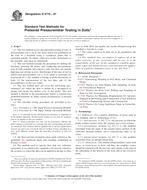Potřebujeme váš souhlas k využití jednotlivých dat, aby se vám mimo jiné mohly ukazovat informace týkající se vašich zájmů. Souhlas udělíte kliknutím na tlačítko „OK“.
ASTM D4719-07
Standard Test Methods for Prebored Pressuremeter Testing in Soils (Withdrawn 2016)
Automaticky přeložený název:
Standardní Zkušební metody pro předvrtané presiometrických testování v půdách
NORMA vydána dne 15.2.2007
Informace o normě:
Označení normy: ASTM D4719-07
Poznámka: NEPLATNÁ
Datum vydání normy: 15.2.2007
Kód zboží: NS-28295
Počet stran: 10
Přibližná hmotnost: 30 g (0.07 liber)
Země: Americká technická norma
Kategorie: Technické normy ASTM
Anotace textu normy ASTM D4719-07 :
Keywords:
in situ test, modulus, limit pressure, stress-strain, ICS Number Code 93.020 (Earth works. Excavations. Foundation construction. Underground works)
Doplňující informace
| Significance and Use | ||||||||||||||||||
|
This test method provides a stress-strain response of the soil in situ. A pressuremeter modulus and a limit pressure is obtained for use in geotechnical analysis and foundation design. The results of this test method are dependent on the degree of disturbance during drilling of the borehole and insertion of the pressuremeter probe. Since disturbance cannot be completely eliminated, the interpretation of the test results should include consideration of conditions during drilling. This disturbance is particularly significant in very soft clays and very loose sands. Disturbance may not be eliminated completely but should be minimized for the prebored pressuremeter design rules to be applicable. Note 5—The quality of the result produced by this test method is dependent on the competence of the personnel performing it, and the suitability of the equipment and facilities used. Agencies that meet the criteria of Practice D3740 are generally considered capable of competent and objective testing/sampling/ inspection/etc. Users of this test method are cautioned that compliance with Practice D3740 does not in itself assure reliable results. Reliable results depend on many factors; Practice D3740 provides a means of evaluating some of those factors. TABLE 1 Typical Probe and Borehole Dimensions
|
||||||||||||||||||
| 1. Scope | ||||||||||||||||||
|
1.1 This test method covers pressuremeter testing of soils. A pressuremeter test is an in situ stress-strain test performed on the wall of a borehole using a cylindrical probe that is expanded radially. To obtain viable test results, disturbance to the borehole wall must be minimized. 1.2 This test method includes the procedure for drilling the borehole, inserting the probe, and conducting pressuremeter tests in both granular and cohesive soils, but does not include high pressure testing in rock. Knowledge of the type of soil in which each pressuremeter test is to be made is necessary for assessment of (1) the method of boring or probe placement, or both, (2) the interpretation of the test data, and (3) the reasonableness of the test results. 1.3 This test method does not cover the self-boring pressuremeter, for which the hole is drilled by a mechanical or jetting tool inside the hollow core of the probe. This test method is limited to the pressuremeter which is inserted into predrilled boreholes or, under certain circumstances, is inserted by driving. 1.4 Two alternate testing procedures are provided as follows: 1.4.1 Procedure A—The Equal Pressure Increment Method. 1.4.2 Procedure B—The Equal Volume Increment Method. Note 1—A standard for the self-boring pressuremeter is scheduled to be developed separately. Pressuremeter testing in rock may be standardized as an adjunct to this test method. Note 2—Strain-controlled tests also can be performed, whereby the probe volume is increased at a constant rate and corresponding pressures are measured. This method shall be applied only if special requirements must be met and is not covered by this test method. Strain-controlled tests may yield different results than the procedure described in this test method. 1.5 All observed and calculated values shall conform to the guidelines for significant digits and rounding established in Practice D6026. 1.6 The method used to specify how data are collected, calculated, or recorded in this standard is not directly related to the accuracy to which the data can be applied in design or other uses, or both. How one applies the results obtained using this standard is beyond its scope. 1.7 The values stated in SI units are to be regarded as the standard. 1.8 This standard does not purport to address all of the safety concerns, if any, associated with its use. It is the responsibility of the user of this standard to establish appropriate safety and health practices and determine the applicability of regulatory limitations prior to use. See Note 7. |
||||||||||||||||||
| 2. Referenced Documents | ||||||||||||||||||
|
||||||||||||||||||
Doporučujeme:
Aktualizace zákonů
Chcete mít jistotu o platnosti užívaných předpisů?
Nabízíme Vám řešení, abyste mohli používat stále platné (aktuální) legislativní předpisy.
Chcete vědět více informací? Podívejte se na tuto stránku.




 Cookies
Cookies
